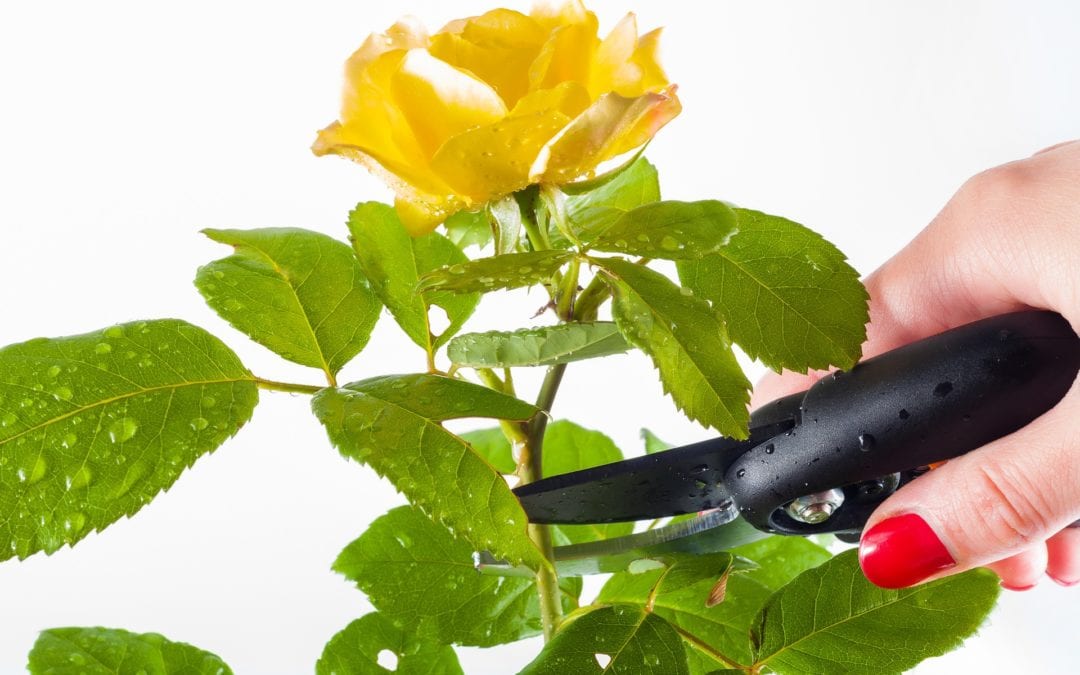It’s rose pruning season! Our tips in today’s blog are specifically for bush/shrub type of roses that repeat bloom throughout the year. Roses that only bloom during spring (many climbers) should not be pruned until after they have finished their spring blooming period.
When to prune: Heavy pruning for roses takes place twice a year in San Antonio; once in early spring, and again in late August. The best time for pruning spring roses is the last two weeks of February. This gives you time to prune away the old wood before spring brings on new growth. We use Valentine’s Day as a good reminder of when to get your pruning started.


What to use: Start off with clean, oiled, sharp bypass pruners. Need a new pair? Rainbow Gardens carries Corona Bypass Pruners and this type of pruner makes the cleanest cuts. It’s a really good idea to sanitize your pruners between making each cut. You can do this easily by dipping your pruners into a container filled with a 9:1 water/bleach mixture. This will greatly reduce the threat of spreading disease.
How much to prune: Spring rose pruning is the time to get pretty severe with your cuts. You can usually expect to prune about one/third to one/half your rose bush/shrub, leaving your rosebush about knee high. This type of pruning will spur on new growth and encourage the production of spring blooms.
How to prune: Remove old, gray canes (branches) by cutting them back to the bud union (swollen knobby area at base of plant). Also remove any weak, spindly growth in the inside of the bush. Remove suckers that sprout out below the swollen, knobby base of the rose bush. When reducing the height of your rosebush, look for buds that face outward from the middle of the plant and make cuts directly above these buds. Prune at an angle so that the new growth will face out from the center of the bush. This type of pruning creates an open vase shape, which allows for great air circulation and encourages more spreading growth. Bag and discard cuttings and foliage from the soil around rosebushes. This helps eliminate the threat of disease being transferred to new growth.
(Pics show the area to cut just above the bud, and the swollen bud union at the base of plant where you remove old gray canes.)




After pruning: Since rosebushes are dormant at this time, spraying them with Neem Oil is recommended. This horticultural oil spray helps prevent and treat fungus issues, mites, scale and other insects. We recommend getting into the practice of spraying Neem Oil only in the morning hours or later in the evening. Although there won’t be an issue this early in the year, when temperatures get warmer, Neem Oil can damage foliage when sprayed in hot afternoons
What’s next: Time to go ahead and stock up on your rose fertilizer for next month’s spring growth. We love Rose Glow and Espoma Rose-Tone. Create a monthly feeding schedule, then sit back and enjoy those beautiful rose blooms as they put on a spectacular show the next few months! For another great source of rose information, you can always contact The San Antonio Rose Society, they’d love to share their knowledge with you. See our blog on more tips for growing roses successfully here.
~The Happy Gardener, Lisa Mulroy




Hi!! Reading this interesting info on rose pruning. After pruning you mentioned spraying w/Neem oil is that just one time ? Or how often & how long!
Thank you
Debra DeLeon
Hi Debra,
Thank you for reading! I am attaching info from the San Antonio Rose Society with plenty of info on rose maintenance. The Neem oil is used as a preventative measure right after spring pruning to erradicate any over wintering bugs or fungus issues. Folow up sprays with fungicides like copper sulfate or insecticides may be needed. Check out the info from the San Antonio Rose Society for application guidelines and recommended products.https://www.rainbowgardens.biz/wp-content/uploads/2013/09/Rose-Care-and-Fertilization.pdf
Link not working
Hi Carolyn,
Can you let me know the specific link that is not working? All links included in the blog appear to be connected from this end. The link to the SA Rose Society and the link to the additional rose blog lead to the correct locations. Is there another link somewhere else you are trying to access?
Good afternoon
I have belinda’s blush rose, knockout rose and caldwell pink rose, can I put bioadvanced 12 months tree & shrub pesticide?
Do you currently have pests on your roses? You might want to identify what they are to make sure you are treating for correct insect.
Thank you for sharing! We have various clients with Rose Bushes and strive to provide the highest level of service. This article was very informational and greatly appreciated!
Kramer,
Thank you so much for the kind words. We appreciate you taking the time to read our blogs! Glad we could offer something you found helpful.
When is the best time to plant roses?
Hello Jean,
The rule is that the absolute best time to plant roses, trees, and shrubs in Texas is in the fall. This is so that the plants have the most time to get established so they will be able to tolerate and withstand the heat of the summer. HOWEVER, late winter/early spring (a.k.a. right now…) is also a suitable time to plant your roses; particularly because early spring is when we receive our roses at the nursery and have our best selection. Avoid planting in summer and the months close to it. Hope this helps. Keep an eye out for upcoming blogs this month with tips for successfully growing roses. Thank you!
Hi,can I prune and replant my rose at the same time?
Thanks
Eva,
Yes, you can prune and replant your roses at the same time. This will force energy into the roots to help them get established before the heat of the summer. Best to get it finished by this month if you can.
You said prune in late August but you didn’t mention how much to prune.
Prune about a 1/3 from the top. Remove any twiggy growth and/or damaged limbs. Complete no later than end of the month. Climbing roses and heirlooms should be left to only minimal “clean up pruning” as they flower on last spring’s new growth.